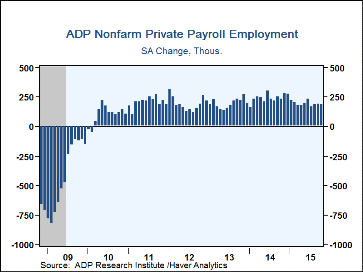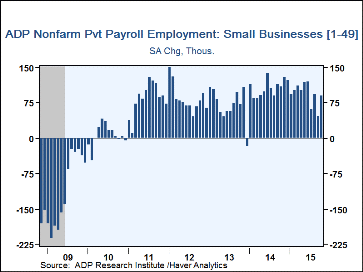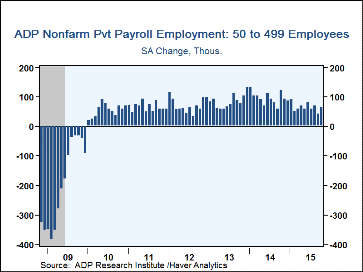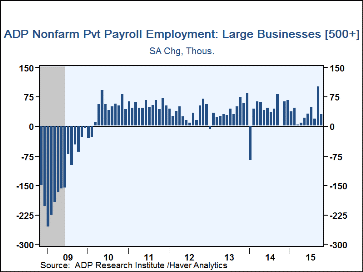 Global| Nov 04 2015
Global| Nov 04 2015U.S. ADP Payroll Increase Paced by Small Businesses
by:Tom Moeller
|in:Economy in Brief
Summary
The ADP/Moody's National Employment Report indicated that nonfarm private sector payrolls increased 182,000 during October after a 190,000 September rise, revised from 200,000. The latest was firmer than expectations for a 178,000 [...]
The ADP/Moody's National Employment Report indicated that nonfarm private sector payrolls increased 182,000 during October after a 190,000 September rise, revised from 200,000. The latest was firmer than expectations for a 178,000 gain in the Action Economics Forecast Survey. During the last ten years, there has been a 97% correlation between the change in the ADP figure and the change in nonfarm private sector payrolls as measured by the Bureau of Labor Statistics.
The ADP survey is based on ADP's business payroll transaction system covering 411,000 companies and nearly 24 million employees. The data are processed by Moody's Analytics Inc., then calibrated and aligned with the BLS establishment survey data. The ADP data cover private sector employment, not government.
Small-businesses strengthened hiring by 90,000 workers (2.4% y/y) in October after a 47,000 rise in the prior month. Medium-sized businesses added to payrolls by 63,000 individuals (1.9% y/y) after a 42,000 increase. Large businesses moderated hiring and added 29,000 (1.8% y/y) workers following a 101,000 September surge. That gain mostly reflected a jump in hiring by companies with 1,000 or more employees.
Hiring in the goods-producing sector of the economy increased 24,000 (1.2% y/y), the largest gain in nine months. Service industry hiring grew a lessened 158,000 (2.3% y/y), the smallest increase since January 2014. Payrolls in trade, transportation & utilities industries improved 35,000 (1.9% y/y). Professional & business services payrolls grew 13,000 (2.4% y/y). That compares to monthly increases as high as 81,000 at the peak in June 2014. Employment in financial activities improved 9,000 (1.8% y/y). Hiring in the construction sector remained firm as it posted a 35,000 increase (4.9% y/y), a ten year high. Factory sector payrolls eased 2,000 (+0.3% y/y) after a 17,000 decline.
The ADP National Employment Report data are maintained in Haver's USECON database; historical figures date back to April 2001 for the total and industry breakdown and back to January 2005 for the business size breakout. The expectation figure is available in Haver's AS1REPNA database.
| ADP/Moody's National Employment Report | Oct | Sep | Aug | Oct Y/Y | 2014 | 2013 | 2012 |
|---|---|---|---|---|---|---|---|
| Nonfarm Private Payroll Employment (m/m chg, 000s) | 182 | 190 | 182 | 2.1% | 2.3% | 1.9% | 2.3% |
| Small Payroll (1-49) | 90 | 47 | 92 | 2.4 | 2.1 | 1.9 | 2.5 |
| Medium Payroll (50-499) | 63 | 42 | 70 | 1.9 | 2.8 | 2.2 | 2.1 |
| Large Payroll (>500) | 29 | 101 | 19 | 1.8 | 1.8 | 1.6 | 2.1 |
| Goods-Producing | 24 | 8 | 13 | 1.2 | 2.3 | 1.7 | 2.2 |
| Construction | 35 | 34 | 18 | 4.9 | 4.6 | 3.5 | 2.5 |
| Manufacturing | -2 | -17 | 3 | 0.3 | 1.2 | 0.9 | 1.6 |
| Service-Producing | 158 | 182 | 169 | 2.3 | 2.3 | 2.0 | 2.3 |
Tom Moeller
AuthorMore in Author Profile »Prior to joining Haver Analytics in 2000, Mr. Moeller worked as the Economist at Chancellor Capital Management from 1985 to 1999. There, he developed comprehensive economic forecasts and interpreted economic data for equity and fixed income portfolio managers. Also at Chancellor, Mr. Moeller worked as an equity analyst and was responsible for researching and rating companies in the economically sensitive automobile and housing industries for investment in Chancellor’s equity portfolio. Prior to joining Chancellor, Mr. Moeller was an Economist at Citibank from 1979 to 1984. He also analyzed pricing behavior in the metals industry for the Council on Wage and Price Stability in Washington, D.C. In 1999, Mr. Moeller received the award for most accurate forecast from the Forecasters' Club of New York. From 1990 to 1992 he was President of the New York Association for Business Economists. Mr. Moeller earned an M.B.A. in Finance from Fordham University, where he graduated in 1987. He holds a Bachelor of Arts in Economics from George Washington University.










